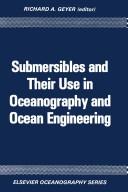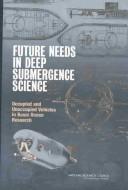| Listing 1 - 10 of 25 | << page >> |
Sort by
|
Book
ISBN: 1728102537 1728102545 Year: 2018 Publisher: Piscataway, New Jersey : Institute of Electrical and Electronics Engineers,
Abstract | Keywords | Export | Availability | Bookmark
 Loading...
Loading...Choose an application
- Reference Manager
- EndNote
- RefWorks (Direct export to RefWorks)
Oceanographic submersibles --- Autonomous underwater vehicles --- AUVs (Autonomous underwater vehicles) --- Underwater robotic vehicles --- Unmanned submersibles --- Unmanned undersea vehicles --- Unmanned underwater vehicles --- Autonomous vehicles --- Submersibles --- Deep diving vehicles --- Deep-sea research vessels --- Deep submergence vehicles --- Manned exploration devices --- Automated vehicles
Book
ISBN: 9782889193042 Year: 2015 Publisher: Frontiers Media SA
Abstract | Keywords | Export | Availability | Bookmark
 Loading...
Loading...Choose an application
- Reference Manager
- EndNote
- RefWorks (Direct export to RefWorks)
Global warming has dramatically increased the frequency and severity of flooding events worldwide. As a result, many man-made and natural ecosystems have become flood-prone. For plants, the main consequence of flooding is the drastic reduction of oxygen availability that restricts respiratory energy production and finally affects survival. Flooding can negatively influence crop production and wild plant distributions, since most plants are sensitive to excessively wet conditions. However, plants have evolved a broad spectrum of adaptive responses to oxygen deficiency that eventually leads to tolerance. Many of these morphological and physiological adaptations have been described in some crops and wild plant species and considerable progress has been made in understanding the molecular aspects governing tolerance traits. Moreover, the molecular mechanism of plant oxygen sensing has been recently elucidated. However, many other aspects concerning plant acclimation responses to flooding remain unanswered.
Botany. --- Plants. --- Flora --- Plant kingdom --- Plantae --- Vascular plants --- Vegetable kingdom --- Vegetation --- Wildlife --- Organisms --- Botany --- Botanical science --- Floristic botany --- Phytobiology --- Phytography --- Phytology --- Plant biology --- Plant science --- Biology --- Natural history --- Plants --- submergence --- hypoxia --- Anoxia --- low oxygen --- waterlogging --- flooding
Book
Year: 2021 Publisher: Basel, Switzerland MDPI - Multidisciplinary Digital Publishing Institute
Abstract | Keywords | Export | Availability | Bookmark
 Loading...
Loading...Choose an application
- Reference Manager
- EndNote
- RefWorks (Direct export to RefWorks)
Molecular oxygen deficiency leads to altered cellular metabolism and can dramatically reduce crop productivity. Nearly all crops are negatively affected by a lack of oxygen (hypoxia) due to adverse environmental conditions such as excessive rain and soil waterlogging. Extensive efforts to fully understand how plants sense oxygen deficiency and their ability to respond using different strategies are crucial to increase hypoxia tolerance. Progress in our understanding has been significant in recent years. This topic certainly deserves more attention from the academic community; therefore, we have compiled a series of articles reflecting the advancements made thus far.
ethylene --- Ein2 --- germination --- RbohD --- submergence --- hypoxia --- post-submergence recovery --- legumes --- plant water relations --- shoot to root ratio --- Lotus japonicus --- leaf greenness --- leaf desiccation --- stomatal conductance --- aerenchyma --- auxin --- rice (Oryza sativa) --- root --- waterlogging --- leaf gas exchange --- waterlogging tolerance --- organic compound --- plant growth --- Physalis peruviana L. --- anaerobiosis --- anoxia --- Arabidopsis --- flooding --- rice --- development --- apoplastic barrier --- barrier to radial oxygen loss (ROL) --- lignin --- Oryza glumaepatula --- O. rufipogon --- rice (O. sativa) --- suberin --- wild rice --- acetolactate synthase --- ethanol fermentation --- imidazolinones --- mode of action --- aerobic fermentation --- Oryza sativa --- Submergence --- Activity of antioxidant enzymes --- Chlorophyll content --- phytoglobin --- VII Ethylene Response Factor --- PRT6 N-degron pathway of proteolysis --- Solanum tuberosum --- Solanum lycopersicum --- Solanum dulcamara --- coleoptile --- root hypoxia --- oxygen sensing --- jasmonate --- root meristem --- abiotic stress --- RNA-seq --- transcription factor --- fruit trees --- Prunus --- hypertrophied lenticels --- anaerobic fermentation --- energy metabolism --- root respiration --- anoxic signaling --- potassium --- pH --- acidification --- fluorescence microscopy --- Triticum aestivum --- direct seeding --- anaerobic germination --- low O2 stress --- regulatory mechanism --- metabolic adaptation --- drought --- alternated stress --- maize --- teosinte --- microRNAs --- metabolomics --- phloem --- n/a
Book
ISBN: 9535155598 9533074329 Year: 2011 Publisher: IntechOpen
Abstract | Keywords | Export | Availability | Bookmark
 Loading...
Loading...Choose an application
- Reference Manager
- EndNote
- RefWorks (Direct export to RefWorks)
Autonomous Underwater Vehicles (AUVs) are remarkable machines that revolutionized the process of gathering ocean data. Their major breakthroughs resulted from successful developments of complementary technologies to overcome the challenges associated with autonomous operation in harsh environments. Most of these advances aimed at reaching new application scenarios and decreasing the cost of ocean data collection, by reducing ship time and automating the process of data gathering with accurate geo location. With the present capabilities, some novel paradigms are already being employed to further exploit the on board intelligence, by making decisions on line based on real time interpretation of sensor data. This book collects a set of self contained chapters covering different aspects of AUV technology and applications in more detail than is commonly found in journal and conference papers. They are divided into three main sections, addressing innovative vehicle design, navigation and control techniques, and mission preparation and analysis. The progress conveyed in these chapters is inspiring, providing glimpses into what might be the future for vehicle technology and applications.
Oceanographic submersibles. --- Remote submersibles. --- Submersibles. --- Submergibles --- Undersea vehicles --- Underwater vehicles --- Vehicles --- Remotely controlled underwater vehicles --- Remotely operated underwater vehicles --- ROVs (Submersibles) --- Underwater robotic vehicles --- Unmanned submersibles --- Unmanned undersea vehicles --- Unmanned underwater vehicles --- URVs (Submersibles) --- UUVs (Submersibles) --- Submersibles --- Vehicles, Remotely piloted --- Deep diving vehicles --- Deep-sea research vessels --- Deep submergence vehicles --- Manned exploration devices --- Automotive technology & trades
Book
ISBN: 1457720558 145772054X 1457720566 9781457720567 9781457720543 Year: 2012 Publisher: [Place of publication not identified] IEEE
Abstract | Keywords | Export | Availability | Bookmark
 Loading...
Loading...Choose an application
- Reference Manager
- EndNote
- RefWorks (Direct export to RefWorks)
Oceanographic submersibles --- Remote submersibles --- Earth & Environmental Sciences --- Marine Science --- Remotely controlled underwater vehicles --- Remotely operated underwater vehicles --- ROVs (Submersibles) --- Underwater robotic vehicles --- Unmanned submersibles --- Unmanned undersea vehicles --- Unmanned underwater vehicles --- URVs (Submersibles) --- UUVs (Submersibles) --- Deep diving vehicles --- Deep-sea research vessels --- Deep submergence vehicles --- Manned exploration devices --- Submersibles --- Vehicles, Remotely piloted --- Autonomous underwater vehicles --- AUVs (Autonomous underwater vehicles) --- Autonomous vehicles --- Automated vehicles
Book
ISBN: 1479943452 1479943436 1479943444 9781479943449 Year: 2014 Publisher: IEEE
Abstract | Keywords | Export | Availability | Bookmark
 Loading...
Loading...Choose an application
- Reference Manager
- EndNote
- RefWorks (Direct export to RefWorks)
Oceanographic submersibles --- Remote submersibles --- Autonomous underwater vehicles --- AUVs (Autonomous underwater vehicles) --- Underwater robotic vehicles --- Unmanned submersibles --- Unmanned undersea vehicles --- Unmanned underwater vehicles --- Automated vehicles --- Submersibles --- Remotely controlled underwater vehicles --- Remotely operated underwater vehicles --- ROVs (Submersibles) --- URVs (Submersibles) --- UUVs (Submersibles) --- Vehicles, Remotely piloted --- Deep diving vehicles --- Deep-sea research vessels --- Deep submergence vehicles --- Manned exploration devices

ISBN: 0444415459 9786611772338 128177233X 0080870538 9780444415455 9780080870533 0444416234 9780444416230 Year: 1977 Publisher: Amsterdam ; New York : New York : Elsevier Scientific Pub. Co. ; distributors for the U.S. and Canada, Elsevier North-Holland,
Abstract | Keywords | Export | Availability | Bookmark
 Loading...
Loading...Choose an application
- Reference Manager
- EndNote
- RefWorks (Direct export to RefWorks)
Submersibles and Their Use in Oceanography and Ocean Engineering
Ocean engineering. --- Oceanographic submersibles. --- Underwater exploration. --- Deep-sea engineering --- Oceaneering --- Submarine engineering --- Underwater engineering --- Engineering --- Marine resources --- Oceanography --- Exploration, Submarine --- Exploration, Underwater --- Ocean exploration --- Submarine exploration --- Under water exploration --- Undersea exploration --- Deep diving vehicles --- Deep-sea research vessels --- Deep submergence vehicles --- Manned exploration devices --- Submersibles --- Equipment and supplies --- Oceanographic submersibles --- Underwater exploration --- Ocean engineering
Book
ISBN: 1509024425 1509024433 Year: 2016 Publisher: New York : IEEE,
Abstract | Keywords | Export | Availability | Bookmark
 Loading...
Loading...Choose an application
- Reference Manager
- EndNote
- RefWorks (Direct export to RefWorks)
Oceanographic submersibles --- Remote submersibles --- Remotely controlled underwater vehicles --- Remotely operated underwater vehicles --- ROVs (Submersibles) --- Underwater robotic vehicles --- Unmanned submersibles --- Unmanned undersea vehicles --- Unmanned underwater vehicles --- URVs (Submersibles) --- UUVs (Submersibles) --- Submersibles --- Vehicles, Remotely piloted --- Deep diving vehicles --- Deep-sea research vessels --- Deep submergence vehicles --- Manned exploration devices

ISBN: 1280176628 9786610176625 0309529174 9780309529174 9781280176623 0309091144 9780309091145 Year: 2004 Publisher: Washington, D.C. : National Academies Press,
Abstract | Keywords | Export | Availability | Bookmark
 Loading...
Loading...Choose an application
- Reference Manager
- EndNote
- RefWorks (Direct export to RefWorks)
Underwater exploration --- Oceanographic submersibles --- Remote submersibles --- Remotely controlled underwater vehicles --- Remotely operated underwater vehicles --- ROVs (Submersibles) --- Underwater robotic vehicles --- Unmanned submersibles --- Unmanned undersea vehicles --- Unmanned underwater vehicles --- URVs (Submersibles) --- UUVs (Submersibles) --- Submersibles --- Vehicles, Remotely piloted --- Deep diving vehicles --- Deep-sea research vessels --- Deep submergence vehicles --- Manned exploration devices --- Exploration, Submarine --- Exploration, Underwater --- Ocean exploration --- Submarine exploration --- Under water exploration --- Undersea exploration --- Oceanography
Book
Year: 2021 Publisher: Basel, Switzerland MDPI - Multidisciplinary Digital Publishing Institute
Abstract | Keywords | Export | Availability | Bookmark
 Loading...
Loading...Choose an application
- Reference Manager
- EndNote
- RefWorks (Direct export to RefWorks)
Molecular oxygen deficiency leads to altered cellular metabolism and can dramatically reduce crop productivity. Nearly all crops are negatively affected by a lack of oxygen (hypoxia) due to adverse environmental conditions such as excessive rain and soil waterlogging. Extensive efforts to fully understand how plants sense oxygen deficiency and their ability to respond using different strategies are crucial to increase hypoxia tolerance. Progress in our understanding has been significant in recent years. This topic certainly deserves more attention from the academic community; therefore, we have compiled a series of articles reflecting the advancements made thus far.
Research & information: general --- Biology, life sciences --- ethylene --- Ein2 --- germination --- RbohD --- submergence --- hypoxia --- post-submergence recovery --- legumes --- plant water relations --- shoot to root ratio --- Lotus japonicus --- leaf greenness --- leaf desiccation --- stomatal conductance --- aerenchyma --- auxin --- rice (Oryza sativa) --- root --- waterlogging --- leaf gas exchange --- waterlogging tolerance --- organic compound --- plant growth --- Physalis peruviana L. --- anaerobiosis --- anoxia --- Arabidopsis --- flooding --- rice --- development --- apoplastic barrier --- barrier to radial oxygen loss (ROL) --- lignin --- Oryza glumaepatula --- O. rufipogon --- rice (O. sativa) --- suberin --- wild rice --- acetolactate synthase --- ethanol fermentation --- imidazolinones --- mode of action --- aerobic fermentation --- Oryza sativa --- Submergence --- Activity of antioxidant enzymes --- Chlorophyll content --- phytoglobin --- VII Ethylene Response Factor --- PRT6 N-degron pathway of proteolysis --- Solanum tuberosum --- Solanum lycopersicum --- Solanum dulcamara --- coleoptile --- root hypoxia --- oxygen sensing --- jasmonate --- root meristem --- abiotic stress --- RNA-seq --- transcription factor --- fruit trees --- Prunus --- hypertrophied lenticels --- anaerobic fermentation --- energy metabolism --- root respiration --- anoxic signaling --- potassium --- pH --- acidification --- fluorescence microscopy --- Triticum aestivum --- direct seeding --- anaerobic germination --- low O2 stress --- regulatory mechanism --- metabolic adaptation --- drought --- alternated stress --- maize --- teosinte --- microRNAs --- metabolomics --- phloem
| Listing 1 - 10 of 25 | << page >> |
Sort by
|

 Search
Search Feedback
Feedback About UniCat
About UniCat  Help
Help News
News